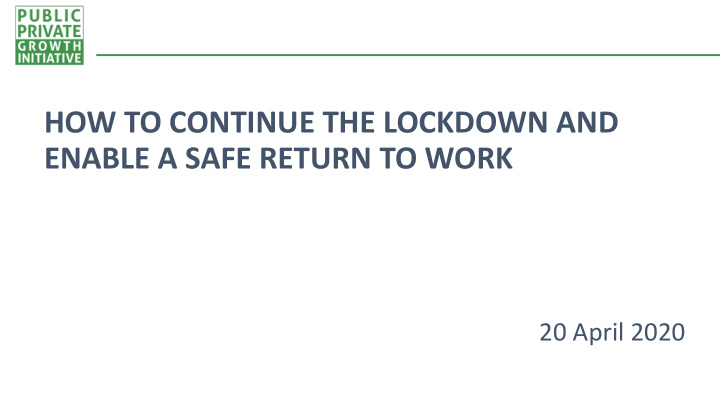



HOW TO CONTINUE THE LOCKDOWN AND ENABLE A SAFE RETURN TO WORK 20 April 2020
FRAMING THE PROBLEM SA needs to maintain the lockdown until health indicators demonstrate otherwise. • Social Problem • Food insecurity • Social transfers are insufficient • Where funds are available, these are extremely difficult for applicants to access • Businesses have closed or liquidated and let their staff go on short wages or on no pay at all • Short term interventions are attempting to provide urgent relief • Fiscal Problem • We face significant fiscal constraints exacerbated given the recent ratings downgrade • Absence of export revenue to maintain the balance of payments; and the reduction in tax makes Government funding of any Covid-19 relief efforts beyond the very short term, unsustainable • Economic Problem • Increasing evidence of businesses under extreme financial stress. • Risk of sustained lockdown is that businesses stall so badly that they are unable to recover at all • Knock-on consequences on employment, turnover, revenue are obvious • SMEs are the hardest hit • Breakdown in value chains
HOW TO GET SOME PARTS OF THE ECONOMY BACK TO WORK SAFELY What must be done immediately • Include further value chain inputs for the category of the regulated essential goods and services • Expand essential goods and services in the regulations, including • Construction of emergency premises, low cost housing, and repair and maintenance to non-essential businesses and services • all exports, subject to PPE provision (and test kits) for the ports staff • all perishable products • goods that are high revenue earners, subject to quantity limits & delivery only • All forms of food products are included, pre-prepared and fast food outlets subject to stringent social distancing controls.
HOW TO GET SOME PARTS OF THE ECONOMY BACK TO WORK SAFELY Which sectors should be allowed to return to work on an incremental basis during the lockdown? • These proposals are based on a bottom-up assessment of sectors a combination of factors to consider: COVID-19 transmission risks, Contribution to economy, Economic & employment stress Option A: Recommended Option B A systematic and carefully calibrated phasing of Gradual expansion of value chain through sectors returning to work exemptions • The governing principles governing both these options are the same: • Strict health protocols to limit the spread of the virus. • Commuter transport solutions • Massive upscaling of production and availability of mitigation interventions • Contribute to testing • Encourage remote return to work wherever possible. • Require continued lockdown for the vulnerable (over 60s and unmanaged pre-existing illnesses)
PHASED RETURN TO WORK OPTION A Risk-based, phased approach to reopening the economy A systematic and carefully - get people back to work safely and as quickly as possible calibrated phasing of - dual approach transmission risk and economic value at risk sectors returning to work Impact of measures Cost Source of funds • Economy is in critical condition, exponential Positive on a net basis - return- • Businesses will risks to jobs, SMEs and whole industries to-work is value creating and implement health • Pragmatic plan for phased reopening (sectors self-sustaining mitigation intervention and timing) to provide certainty, immediate relief and fund development of while dealing with transmission risks necessary tools and • Workable protocols per workspace and protocols with industry commuting space Lead departments Other departments Stakeholders Presidency COGTA, SAPS, NT Business sectors DTIC Trade unions DoH Workers, SMEs Description of the measure & key risks • Reopen the economy safely in phased approach: start with lowest transmission risk x highest economic value • Government and industries design protocol standards at sector level ; businesses develop customised protocols per 16 archetypal work and commuting spaces • Safest commuter transport options implemented (taxi industry support and employer solutions) • Those that can work remotely, over 60s, or with unmanaged health conditions will stay at home • Businesses / industry can be relocked if non-compliant or if epidemiological progress changes • Compliance and monitoring are critical (requires coordination between government and business CEOs) • Risks: pace of phasing (transmission risks v too late to resuscitate the economy), enforcement
HOW TO GET SOME PARTS OF THE ECONOMY BACK TO WORK SAFELY How can this be done? What must be kept under Other solutions that will lockdown at this stage? contribute to maintaining • Health and Safety protocols engagement by an expert the lockdown? • Most sectors, until released. team with industry groupings, • Food security • Places where there are large as well as SME and informal, scale, gatherings such as : own-account worker sector. • Basic education schools and universities, • Risk based Occupational • Emergency funding from religious gatherings, and Health and Safety assessments multilateral organisations, such funerals, dine-in restaurants and mitigation plans to be as the IMF. hotels, taverns and bars. implemented by the relevant • Expedited decision on increase • The borders must remain closed businesses. of various C-19 relief grants for for people. Restrictions on child grant recipients passenger aviation and road • Institutional rescue where travel to remain for now. required (e.g. UIF) • Sectors that cannot put in place safe work solutions
Recommend
More recommend